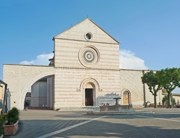


Santa Chiara was built next to the ancient church of San Giorgio, which was then outside the city walls of Assisi. The body of St Clare was brought to San Giorgio from San Damiano after her death in 1253, and some of the sisters moved here at that time to be near her tomb. In 1255, Pope Alexander IV canonised St Clare. He granted plenary indulgences to those visiting her tomb on her feast day, a move that probably provided much of the initial funding for the proposed new church of Santa Chiara.
Some of the nuns from San Damiano probably lived in the hospice next to San Giorgio as they began to negotiate with the canons of San Rufino for the acquisition of the church itself in exchange for San Damiano. The negotiations were not easy. Cardinal John of Toledo arbitrated in favour of the sisters in October, 1253, but the canons refused to comply. In order to ease the negotiations, the sisters secured the church of San Giacomo di Murorupto from the Abbazia di Farfa, and added this to San Damiano as a quid pro quo for San Giorgio. However, the canons continued to resist, possibly because they did not want another major pilgrimage church in Assisi. They finally gave way only with the threat of excommunication.
The construction of the new church began beside San Giorgio in ca. 1257 (when the old hospice was demolished), although the final terms of the transfer of the site were not agreed until 1259.
In 1260, the Bishops of Perugia, Spoleto and Assisi translated the relics of St Clare from San Giorgio to a burial vault under the high altar of the new church. Pope Clement V consecrated this church in 1265.
Convent
A new stretch of city wall was built from Porta Moiano in ca. 1260 to bring the church and convent within the defensive boundary of the city. Those sisters who still remained at San Damiano and those who had moved to San Giacomo di Murorupto were then finally reunited with the others. The nuns used the old church of San Giorgio (which now stood in their cloister) for their own services until its demolition in 1263, and (as noted above) subsequently used the Cappella di San Giorgio for this purpose.
In 1264, the nuns of Sant’ Apollinare, outside Assisi, bought land near the city walls so that they could build a new nunnery. The nuns of Santa Chiara objected, and Pope Clement IV supported them: he decreed that other religious foundations could not be established within 300 canne from their convent. (A canna was about 2 meters). However, Pope Honorius IV reduced this to 140 canne in 1286, and the new Benedictine nunnery Sant’ Apollinare (later San Giuseppe) was built soon after.
Santa Chiara absorbed the community from Santa Margherita, Gubbio in 1447, followed by a series of others from Assisi: Santa Maria di Paradiso in 1459; Santa Lucia in 1475; and Sant Angelo in Panzo in 1476.
Read more:
J. Wood, "Women, Art and Spirituality", (1996) Cambridge
M. Bigaroni, "The Church of San Giorgio in Assisi and the first Expansion of the Medieval Walls", Greyfriars Review 8.1 (1994) 57-102
M. Bigaroni et al. "La Basilica di Santa Chiara in Assisi", (1994) Perugia
R. Miller, "In the Footsteps of St Clare", (1993) St Bonaventure, New York
Proceed to: Exterior Interior Cappella di San Giorgio
Return to Nunneries of Assisi.
Return to Monuments of Assisi.
Return to Walk II.
Return to the home page on Assisi.

